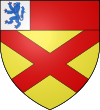Bruce clan
| Clan Bruce | |||
|---|---|---|---|
| Brùs | |||

Crest: A lion stantan Azure armed and langued Gules
|
|||
| Motto | FUIMUS (We have been) | ||
| Profile | |||
| Region | Lowlands | ||
| District | Fife | ||
| Chief | |||
 |
|||
| The Rt. Hon. Andrew Douglas Bruce | |||
| The 11th Earl of Elgin and 15th Earl of Kincardine | |||
| Seat | Broomhall House | ||
| Historic seat |
Lochmaben Castle Clackmannan Tower |
||
|
|||
|
|||
|
|||
Clan Bruce (Scottish Gaelic: Clann Brus) is a Scottish clan from Kincardine in Scotland. It was a royal house in the 14th century, producing two kings of Scotland.
The surname Bruce comes from the French de Brus or de Bruis, derived from the lands now called Brix, situated between Cherbourg and Valognes in Normandy, France. There is no evidence to support a claim that a member of the family, Robert de Brix, served under William the Conqueror during the Norman Conquest of England. This notion is now believed to have originated in unreliable lists, derived from the later Middle Ages, of people who supposedly fought at the Battle of Hastings.
Both the English and Scots lines of the Brus/Bruce family demonstrably descend from Robert de Brus, 1st Lord of Annandale who came to England in 1106. Robert de Brus was a companion-in-arms of Prince David, later David I of Scotland. In 1124 he followed David north to reclaim his kingdom. When a civil war broke out in England between Empress Matilda and her cousin, Stephen, David I of Scotland led a force into England. However de Brus did not follow David and instead joined the English and at the Battle of the Standard in 1138 he took prisoner his own son, who was now Lord of the lands of Annandale. Robert de Brus, 1st Lord of Annandale died on 11 May 1141 and was buried at Gysburn.
The foundation for the Bruce royal claim came in 1219 when Robert Bruce, 4th Lord of Annandale married Isobel of Huntingdon, daughter of David of Scotland, 8th Earl of Huntingdon and niece of William the Lion. The union brought both great wealth, with the addition of lands in both England and Scotland. Their son, Robert Bruce, 5th Lord of Annandale, known as 'the competitor' was sometime Tanist (a particularly Gaelic type of heir) to the throne. On the death of Alexander III of Scotland both Bruce and John Balliol claimed succession. Margaret, Alexander's infant granddaughter was named as heir, however, she died in 1290 travelling to Scotland to claim her throne. Soon after the death of young queen Margaret, fearing civil war between the Bruce and Balliol families and their supporters, the Guardians of Scotland asked the kingdom's southern neighbour, Edward I of England to arbitrate among the claimants in order to avoid civil war. Edward I saw this as the opportunity he had long been waiting for to conquer Scotland as he had conquered Wales and rule over all the British Isles. In 1292 Edward chose Balliol who swore allegiance to the English monarch. It was not long, however, before Balliol rebelled against Edward, eventually leading to John's defeat and forced abdication after the Battle of Dunbar in 1296.
...
Wikipedia
